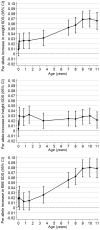Genetic markers of adult obesity risk are associated with greater early infancy weight gain and growth
- PMID: 20520848
- PMCID: PMC2876048
- DOI: 10.1371/journal.pmed.1000284
Genetic markers of adult obesity risk are associated with greater early infancy weight gain and growth
Abstract
Background: Genome-wide studies have identified several common genetic variants that are robustly associated with adult obesity risk. Exploration of these genotype associations in children may provide insights into the timing of weight changes leading to adult obesity.
Methods and findings: Children from the Avon Longitudinal Study of Parents and Children (ALSPAC) birth cohort were genotyped for ten genetic variants previously associated with adult BMI. Eight variants that showed individual associations with childhood BMI (in/near: FTO, MC4R, TMEM18, GNPDA2, KCTD15, NEGR1, BDNF, and ETV5) were used to derive an "obesity-risk-allele score" comprising the total number of risk alleles (range: 2-15 alleles) in each child with complete genotype data (n = 7,146). Repeated measurements of weight, length/height, and body mass index from birth to age 11 years were expressed as standard deviation scores (SDS). Early infancy was defined as birth to age 6 weeks, and early infancy failure to thrive was defined as weight gain between below the 5th centile, adjusted for birth weight. The obesity-risk-allele score showed little association with birth weight (regression coefficient: 0.01 SDS per allele; 95% CI 0.00-0.02), but had an apparently much larger positive effect on early infancy weight gain (0.119 SDS/allele/year; 0.023-0.216) than on subsequent childhood weight gain (0.004 SDS/allele/year; 0.004-0.005). The obesity-risk-allele score was also positively associated with early infancy length gain (0.158 SDS/allele/year; 0.032-0.284) and with reduced risk of early infancy failure to thrive (odds ratio = 0.92 per allele; 0.86-0.98; p = 0.009).
Conclusions: The use of robust genetic markers identified greater early infancy gains in weight and length as being on the pathway to adult obesity risk in a contemporary birth cohort.
Conflict of interest statement
George Davey Smith is on the Editorial Board of
Figures


References
-
- Dietz WH. Critical periods in childhood for the development of obesity. American Journal of Clinical Nutrition. 1994;59:955–959. - PubMed
-
- Whitaker RC, Wright JA, Pepe MS, Seidel KD, Dietz WH. Predicting obesity in young adulthood from childhood and parental obesity. N Engl J Med. 1997;337:869–873. - PubMed
Publication types
MeSH terms
Substances
Grants and funding
LinkOut - more resources
Full Text Sources
Medical

